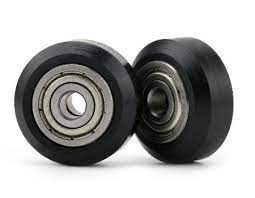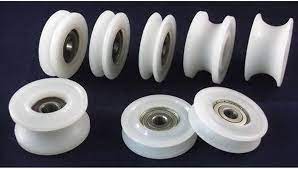Product Description
Proway Shower Pulleys/Roller/Wheels for Tempered Glass Sliding Shower Door (HL-613)
| Model | HL-613 |
| Material | Plastic Chrome |
| Wheel Diameter | 23MM |
| Color | Grey |
| MOQ | 100pcs |
| Packing | Standard export carton |
/* January 22, 2571 19:08:37 */!function(){function s(e,r){var a,o={};try{e&&e.split(“,”).forEach(function(e,t){e&&(a=e.match(/(.*?):(.*)$/))&&1
| After-sales Service: | 1 Year |
|---|---|
| Warranty: | 1 Year |
| Surface Treatment: | Chrome Plated |
| Samples: |
US$ 20/Piece
1 Piece(Min.Order) | Order Sample |
|---|
| Customization: |
Available
| Customized Request |
|---|
.shipping-cost-tm .tm-status-off{background: none;padding:0;color: #1470cc}
| Shipping Cost:
Estimated freight per unit. |
about shipping cost and estimated delivery time. |
|---|
| Payment Method: |
|
|---|---|
|
Initial Payment Full Payment |
| Currency: | US$ |
|---|
| Return&refunds: | You can apply for a refund up to 30 days after receipt of the products. |
|---|
Can plastic pulleys withstand exposure to environmental conditions?
Plastic pulleys are designed to withstand exposure to various environmental conditions. Here’s a detailed explanation:
1. Moisture and Humidity:
Plastic pulleys are typically made from materials that are resistant to moisture and humidity. They have inherent properties that prevent water absorption, reducing the risk of swelling, warping, or degradation. This makes plastic pulleys suitable for use in environments with high humidity or where occasional exposure to moisture is expected, such as garages or outdoor applications.
2. Temperature Extremes:
Plastic pulleys exhibit different levels of temperature resistance depending on the specific material used. Many plastic pulleys are designed to withstand a wide range of temperatures, including both high and low extremes. For example, some pulleys made from engineering-grade plastics can operate reliably in temperatures ranging from -40°C to 100°C (-40°F to 212°F). However, it’s important to check the manufacturer’s specifications for temperature limits and choose pulleys that are suitable for the specific environment in which they will be used.
3. UV Exposure:
Extended exposure to ultraviolet (UV) radiation from the sun can potentially degrade certain types of plastics. However, many plastic pulleys are manufactured with UV stabilizers or additives that provide resistance to UV radiation. These additives help protect the plastic material from UV-induced degradation, such as discoloration, brittleness, or loss of mechanical properties. Plastic pulleys with UV resistance are commonly used in outdoor applications where they are exposed to direct sunlight.
4. Chemical Resistance:
The chemical resistance of plastic pulleys varies depending on the specific material used. Some plastics, such as polypropylene (PP) or polyethylene (PE), have excellent chemical resistance and can withstand exposure to a wide range of chemicals, including solvents, acids, and alkalis. However, other plastics may be more susceptible to chemical attack. It’s important to consider the specific chemicals present in the environment and select plastic pulleys that are compatible and resistant to those substances.
5. Dust and Dirt:
Plastic pulleys are generally resistant to dust and dirt accumulation. Their smooth surfaces and low-friction properties make it difficult for particles to adhere to the pulley’s surface. This reduces the risk of debris interfering with the pulley’s movement or causing excessive wear. However, periodic cleaning may still be necessary to ensure optimal performance and prevent any buildup of contaminants that could affect the pulley’s operation.
6. Impact and Vibration:
Plastic pulleys are designed to withstand the impact and vibration commonly encountered in various applications. The plastic materials used in their construction offer good impact resistance, absorbing and dispersing energy to prevent damage or failure. Additionally, plastic pulleys can dampen vibrations, reducing the strain on the pulley and other components of the system. However, it’s important to choose pulleys with the appropriate material properties and consider the specific impact and vibration levels of the application.
7. Saltwater and Corrosive Environments:
In environments where saltwater or corrosive substances are present, it’s crucial to select plastic pulleys that are specifically designed for such conditions. Certain plastics, such as acetal (POM) or polyvinyl chloride (PVC), offer good resistance to saltwater and corrosion. These materials are commonly used in marine or coastal applications where the pulleys may be exposed to saltwater spray or corrosive atmospheres.
While plastic pulleys are generally designed to withstand exposure to environmental conditions, it’s important to consider the specific requirements of the application and choose pulleys that are suitable for the intended environment. Manufacturers often provide guidance on the recommended materials and specifications for plastic pulleys based on their environmental resistance properties.
Can plastic pulleys be customized for specific machinery and equipment?
Yes, plastic pulleys can be customized to meet the specific requirements of machinery and equipment. Here’s a detailed explanation:
Plastic pulleys offer a high degree of design flexibility, allowing for customization to match the needs of different machinery and equipment. Here are some key points regarding the customization of plastic pulleys:
1. Material Selection:
Plastic pulleys can be manufactured using various types of plastics, such as nylon, polyethylene, acetal (POM), or polyurethane. The choice of material depends on the specific application requirements, including factors like load capacity, wear resistance, chemical resistance, temperature tolerance, and desired friction properties. Different materials can be selected to optimize the performance and durability of the pulley in the given machinery or equipment.
2. Shape and Size:
The shape and size of plastic pulleys can be customized to fit the available space and interface with other components in the machinery or equipment. Manufacturers can design pulleys with specific dimensions, such as diameter, width, and bore size, to ensure proper alignment, belt or chain engagement, and tension. Customized shapes can include flanges, grooves, or other features that facilitate efficient power transmission and enhance the overall functionality of the machinery or equipment.
3. Mounting Options:
Plastic pulleys can be customized with different mounting options to suit the specific requirements of machinery or equipment. Mounting options can include bores, keyways, set screws, or other mechanisms that enable secure attachment to shafts or other rotating components. Customized mounting options ensure proper installation and alignment of the pulleys, contributing to reliable and efficient operation.
4. Groove Configuration:
In belt-driven systems, plastic pulleys can be customized with different groove configurations to accommodate specific belt profiles. Pulleys can be designed with V-grooves, flat grooves, or multi-groove profiles, depending on the type of belt being used. Customized groove configurations ensure optimal belt engagement, tracking, and power transmission, minimizing slippage and maximizing efficiency in the machinery or equipment.
5. Surface Finish:
The surface finish of plastic pulleys can be customized to meet specific requirements. This includes factors such as roughness, texture, or the addition of coatings or treatments. For example, pulley surfaces can be polished or coated to reduce friction, improve wear resistance, or enhance corrosion resistance. Customized surface finishes help optimize the performance and longevity of plastic pulleys in the machinery or equipment.
6. Load Capacity and Reinforcement:
If the machinery or equipment operates under heavy loads or high-stress conditions, plastic pulleys can be customized to enhance their load-carrying capacity. Reinforcing elements, such as fibers or fillers, can be added to the plastic material to increase strength and improve overall durability. Customized reinforcement ensures that the plastic pulleys can withstand the specific loads and forces encountered in the machinery or equipment.
7. Application-Specific Requirements:
Plastic pulleys can be customized to meet application-specific requirements. For example, in food processing equipment, the pulleys may need to comply with specific hygiene standards, such as being made from food-grade materials that are easy to clean. In corrosive environments, the pulleys can be customized to exhibit enhanced chemical resistance. Customization allows plastic pulleys to be tailored to the unique demands of different machinery and equipment.
Overall, plastic pulleys can be customized in terms of material selection, shape and size, mounting options, groove configuration, surface finish, load capacity, and meeting application-specific requirements. This customization ensures that the plastic pulleys seamlessly integrate into the machinery or equipment, providing optimal performance, durability, and reliability in their intended applications.
What is a plastic pulley, and how does it compare to other types of pulleys?
A plastic pulley is a type of pulley made primarily from plastic materials, such as nylon, polyethylene, or polycarbonate. It is designed to perform similar functions as other types of pulleys but offers distinct advantages and considerations. Here’s a detailed comparison of plastic pulleys with other types of pulleys:
1. Material:
Plastic pulleys are specifically engineered to be lightweight and durable. They are resistant to corrosion, moisture, and many chemicals, making them suitable for various environments. In contrast, other types of pulleys, such as metal pulleys, may be heavier and prone to rust or corrosion without proper protection.
2. Cost:
Plastic pulleys tend to be more cost-effective compared to metal pulleys or pulleys made from other materials like ceramic or glass. The manufacturing process for plastic pulleys is generally less expensive, resulting in lower production costs and, consequently, lower prices for consumers.
3. Noise and Vibration:
Plastic pulleys often provide quieter operation compared to metal pulleys. The inherent damping properties of plastic materials help reduce noise and vibration during pulley rotation. This makes plastic pulleys suitable for applications where noise reduction is desired, such as in household appliances or office equipment.
4. Friction and Wear:
Plastic pulleys generally have lower friction coefficients compared to metal pulleys. This can result in reduced wear and tear on the pulley itself and the associated components, such as belts or ropes. However, it’s important to note that the selection of the appropriate plastic material and design considerations are crucial to ensure sufficient strength and wear resistance for the intended application.
5. Load-Bearing Capacity:
While plastic pulleys can handle moderate loads, they may have lower load-bearing capacities compared to metal pulleys. Metal pulleys, especially those made from robust materials like steel or cast iron, are typically stronger and capable of withstanding higher loads. Therefore, in heavy-duty applications or situations where significant forces are involved, metal pulleys may be preferred.
6. Temperature Resistance:
Plastic pulleys have varying temperature resistance depending on the specific material used. Some plastics can withstand a wide temperature range, while others may have limitations. For example, nylon can handle higher temperatures compared to polyethylene. In contrast, metal pulleys generally have higher temperature resistance, making them suitable for high-temperature environments.
7. Application Specificity:
The choice between plastic pulleys and other types of pulleys often depends on the specific application requirements. Plastic pulleys are commonly used in light to moderate load applications, such as in small appliances, office equipment, or recreational devices. Metal pulleys, on the other hand, are often preferred in heavy-duty applications, industrial machinery, or situations where high strength and durability are paramount.
8. Customization:
Plastic pulleys offer flexibility in terms of design and customization options. They can be easily molded into various shapes and sizes, allowing for specific features or geometries to be incorporated. This makes plastic pulleys suitable for applications where precise customization is required. Metal pulleys may require more extensive machining or manufacturing processes for customization.
In conclusion, plastic pulleys offer unique advantages such as lightweight construction, corrosion resistance, cost-effectiveness, noise reduction, and design flexibility. However, they may have limitations in terms of load-bearing capacity and temperature resistance compared to metal pulleys. The choice between plastic pulleys and other types of pulleys depends on factors such as application requirements, load conditions, environmental considerations, and budget constraints.
editor by CX
2024-04-15




